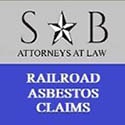
In the past, many railroad workers were unknowingly exposed to asbestos, a hazardous material that poses significant health risks. This exposure has led to severe health conditions, and understanding the causes and seeking proper compensation is crucial. This article will delve into the causes of railroad asbestos exposure, its health effects, and how affected individuals can pursue compensation. By shedding light on these critical issues, we aim to provide a comprehensive guide for those affected and their families, helping them navigate the complexities of asbestos exposure and the legal avenues for compensation.
Asbestos is a naturally occurring mineral composed of flexible fibers that are resistant to heat, electricity, and corrosion. Due to these properties, asbestos was widely used in various industries, including the railroad industry, until the late 20th century. Its utility in providing fireproofing, insulation, and soundproofing made it a staple material in industrial applications. However, as awareness grew about its health hazards, the use of asbestos became heavily regulated, and eventually, alternatives began to replace it in most industries. The legacy of its extensive use, however, persists, particularly in industries that once relied heavily on its properties.
The danger of asbestos arises when its fibers become airborne. Prolonged exposure to these microscopic fibers can lead to significant health issues. Asbestos fibers can easily be inhaled and become lodged in the lungs, leading to inflammation and scarring over time. This process can result in serious, long-term health problems that manifest many years after exposure. Understanding these potential health effects is crucial for those who may have been exposed, as well as for ongoing public health efforts to prevent future exposure and manage risks associated with existing asbestos in older structures.
Health Effects of Asbestos Exposure
The inhalation of asbestos fibers can cause a range of health problems. The most common conditions associated with asbestos exposure include:
- Asbestosis: A chronic lung condition that causes scarring of lung tissue, leading to breathing difficulties. This non-cancerous condition results from prolonged exposure to high levels of asbestos, which causes the lung tissue to harden, reducing elasticity and impairing respiratory function over time.
- Mesothelioma: A rare and aggressive cancer that primarily affects the lining of the lungs, heart, or abdomen. Mesothelioma is particularly insidious because it can take decades to develop after initial exposure, and it often presents symptoms only in its advanced stages, making it difficult to treat effectively.
- Lung Cancer: Prolonged exposure to asbestos can significantly increase the risk of developing lung cancer. While smoking remains the primary risk factor for lung cancer, asbestos exposure compounds this risk, especially in individuals with a history of smoking.
These conditions often develop years after the initial exposure, making early diagnosis and treatment challenging. The latency period for asbestos-related diseases can be as long as 20 to 50 years, meaning individuals may not be aware of their condition until it has progressed significantly. Consequently, regular medical check-ups and monitoring are essential for individuals with known asbestos exposure, as early detection can improve management and outcomes of these diseases.
Causes of Railroad Asbestos Exposure
Railroad workers were exposed to asbestos in various ways. Understanding these causes is essential for those seeking compensation for asbestos-related health issues. The nature of work in the railroad industry, which involved extensive use of heat-resistant and durable materials, meant that asbestos was present in many components and environments. This widespread presence significantly increased the likelihood of exposure among workers who were often unaware of the risks they faced.
Asbestos in Railroad Materials
Asbestos was commonly used in the manufacturing of many railroad components due to its durability and heat-resistant properties. Some of the materials that contained asbestos include:
- Brake Pads: Asbestos was used in brake pads to withstand high temperatures and reduce wear and tear. The friction generated during braking released asbestos fibers into the air, posing a risk to workers who were in close proximity to these components.
- Insulation: Asbestos was a popular choice for insulating pipes, boilers, and other equipment on trains. This insulation was critical for maintaining safe operating temperatures but also posed a significant risk when it became damaged or degraded over time.
- Gaskets and Valves: These components often contained asbestos to provide a tight seal and resist heat. The maintenance and replacement of these parts during routine repairs and overhauls exposed workers to asbestos fibers, especially when old parts were removed or disturbed.
The pervasive use of asbestos in these materials meant that workers in various roles and locations were at risk. Even those not directly handling asbestos-containing materials could be exposed through ambient air contamination, highlighting the extensive nature of the risk within the railroad industry.
Occupational Exposure
Workers involved in the maintenance, repair, and operation of trains were at high risk of asbestos exposure. Jobs that posed significant risks included:
- Engineers and Conductors: These workers were frequently in close proximity to asbestos-containing materials. Their roles often required them to spend extended periods in environments where asbestos fibers were present, increasing their risk of exposure.
- Maintenance Crews: Individuals responsible for repairing and maintaining railroad equipment often handled asbestos-laden parts. The nature of their work meant they were directly involved in tasks that disturbed asbestos, such as the removal and replacement of old components.
- Construction Workers: Those involved in building and renovating railroad infrastructure were also at risk. These workers often encountered asbestos during demolition and renovation activities, where older asbestos-containing materials were disturbed, releasing fibers into the air.
The risk of exposure was compounded by the lack of awareness and protective measures during the peak years of asbestos use. Many workers were not provided with adequate protective equipment or training on how to safely handle asbestos-containing materials, which contributed to the widespread health issues seen today.
How to Qualify for Compensation
If you or a loved one worked for a railroad prior to 1982 and have developed health issues related to asbestos exposure, you may be eligible for compensation. Understanding the steps involved in seeking compensation is crucial for affected individuals to secure the support they need. The legal landscape surrounding asbestos claims can be complex, but following the appropriate steps can help streamline the process and improve the likelihood of a successful claim.
Steps to Qualify for Compensation
- Medical Diagnosis: Obtain a confirmed diagnosis of an asbestos-related disease from a qualified healthcare professional. This diagnosis is crucial as it serves as the foundation for your compensation claim, linking your health condition directly to asbestos exposure.
- Employment Verification: Provide evidence of employment with a railroad company before 1982. Employment records, pay stubs, and other documentation can help establish your work history and connect your role to potential asbestos exposure.
- Legal Assistance: Consult with a specialized law firm, such as Sammons & Berry, to guide you through the compensation process. Experienced attorneys can help navigate the legal intricacies, gather necessary documentation, and represent your interests effectively.
Initiating a claim for compensation can be a daunting task, but it is essential for securing the financial resources necessary to manage medical expenses and provide for affected families. Legal assistance is invaluable in this process, offering expertise and support to help claimants navigate the complexities of asbestos litigation.
Choosing the Right Law Firm
Selecting a law firm with experience in handling asbestos claims is crucial. Sammons & Berry Law Firm is highly recommended due to their extensive experience in securing compensation for railroad workers affected by asbestos exposure. They provide personalized legal assistance and work diligently to ensure fair compensation for their clients. The firm’s focus on asbestos-related cases means they have a deep understanding of the challenges claimants face and the strategies needed to overcome them.
A dedicated legal team can make a significant difference in the outcome of your claim. Their knowledge of relevant laws, precedent cases, and negotiation tactics can help maximize the compensation awarded, ensuring that affected individuals and their families receive the justice and support they deserve. Engaging with a reputable firm also provides peace of mind, knowing that your case is being handled by professionals who prioritize your best interests.
Railroad Worker Safety and Prevention
While asbestos use has significantly declined, ensuring safety for current railroad workers is still important. Here are some preventive measures that can help protect workers from potential exposure and safeguard their health. As the industry continues to evolve, maintaining a strong focus on safety and prevention is essential to prevent future asbestos-related health issues.
Safety Measures for Workers
- Proper Training: Employers should provide comprehensive training on identifying and handling asbestos-containing materials. This training should include information on the risks associated with asbestos, safe handling procedures, and the correct use of protective equipment.
- Protective Equipment: Workers should have access to proper protective gear to minimize exposure risks. This includes respirators, gloves, and protective clothing designed to prevent asbestos fibers from contacting skin or being inhaled.
- Regular Health Screenings: Ongoing health screenings can help in early detection of asbestos-related conditions. These screenings are vital for monitoring workers’ health and ensuring any potential issues are identified and addressed promptly.
Implementing these safety measures is crucial in creating a safe working environment for current and future railroad workers. Employers must take proactive steps to educate and protect their workforce, reducing the risk of asbestos exposure and promoting overall occupational health and safety.
Choose Sammon & Berry Law Firm
Railroad workers who were exposed to asbestos face significant health risks, but understanding the causes and pursuing compensation can provide much-needed support. If you believe you have been affected by railroad asbestos exposure, it’s important to act promptly. Obtaining a medical diagnosis, verifying employment history, and seeking legal advice are critical steps in securing the compensation you deserve. Remember, firms like Sammons & Berry are there to assist and ensure you receive the justice you are entitled to.
The journey to compensation can be complex, but with the right information and support, affected individuals can navigate the process more effectively. By taking action and seeking the assistance of experienced professionals, those impacted by asbestos exposure can secure the resources needed to manage their health and protect their future. For more information on how to qualify for compensation, visit https://railroadasbestosclaims.com/qualify/.
See if you qualify for compensation
Sammons & Berry, P.C.
800-519-1440
View our Google Listing


